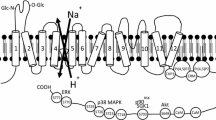Abstract
Eukaryotic cells coordinate specific responses to hormones and growth factors by spatial and temporal organization of “signaling components.” Through the formation of multiprotein complexes, cells are able to generate “signaling components” that transduce hormone signals through proteins, such as PSD-95/Dlg/ZO-1(PDZ)-containing proteins that associate by stable and dynamic interactions. The PDZ homology domain is a common protein interaction domain in eukaryotes and with greater than 500 PDZ domains identified, it is the most abundant protein interaction domain in eukaryotic cells. The NHERF (sodium hydrogen exchanger regulatory factor) proteins are PDZ domain-containing proteins that play an important role in maintaining and regulating cell function. NHERF-1 was initially identified as a brush border membrane-associated phosphoprotein essential for the cAMP/PKA-induced inhibition of the sodium hydrogen exchanger isoform 3 (NHE3). Mouse, rabbit and human renal proximal tubules also express NHERF-2 (E3KARP), a structurally related protein, which in model cell systems also binds NHE3 and mediates its inhibition by cAMP. PDZK1 (NHERF-3) and IKEPP (NHERF-4) were later identified and found to have similar homology domains, leading to their recent reclassification. Although studies have revealed similar binding partners and overlapping functions for the NHERF proteins, it is clear that there is a significant amount of specificity between them. This review focuses primarily on NHERF-1, as the prototypical PDZ protein and will give a brief summary of its role in phosphate transport and the development of some forms of nephrolithiasis.





Similar content being viewed by others
References
Shenolikar S, Voltz JW, Cunningham R, Weinman EJ (2004) Regulation of ion transport by the NHERF family of PDZ proteins. Physiology 19:362–369
Yun CH, Oh S, Zizak M, Steplock D, Tsao S, Tse CM, Weinman EJ, Donowitz M (1997) c-AMP mediated inhibition of the epithelial brush border Na/H exchanger, NHE3, requires an associated regulatory protein. Proc Natl Acad Sci USA 94:3010–3015
Thelin WR, Hodson CA, Milgram SL (2005) Beyond the brush border: NHERF-4 blazes new NHERF turf. J Physiol 576.1:13–19
Cunningham R, E X, Steplock D, Wang F, Huang H, Shenolikar S, Weinman EJ (2004) Defective PTH regulation of NHE3 activity and phosphate adaptation in cultured NHERF-1−/− renal proximal tubule cells. J Biol Chem 279:37815–37821
Hall RA, Premont RT, Chow CW, Blitzer JT, Rahman N, Welsh MF, Lefkowitz RJ (1998) The B2-Adrenergic receptor interacts with the Na/H exchanger regulatory factor to control Na/H exchange. Nature 392:626–630
Mahon MJ, Donowitz M, Yun CC, Segre GV (2002) Na/H exchanger regulatory factor 2 directs parathyroid hormone signaling. Nature 417:858–861
Wang S, Rabb RW, Schatz PJ, Guggino WB, Li M (1998) Peptide binding consensus of the NHERF PDZ1 domain matches the C-terminal sequence of cystic fibrosis transmembrane conductance regulator (CFTR). FEBS Lett 427:103–108
Yoo D, Flagg TP, Olsen O, Raghuram V, Foskett JK, Welling PA (2003) Assembly and trafficking of a multiprotein ROMK (Kir 1.1) channel complex by PDZ interactions. J Biol Chem 279:6863–6873
Shenolikar S, Voltz J, Minkoff CM, Wade J, Weinman EJ (2002) Targeted disruption of the mouse gene encoding a PDZ domain-containing protein adaptor, NHERF-1, promotes Npt2 internalization and renal phosphate wasting. Proc Natl Acad Sci USA 99:11470–11475
Weinman EJ, Bodetti A, Akom M, Cunningham R, Wang F, Wang Y, Liu J, Steplock D, Shenolikar S, Wade JB (2003) NHERF-1 is required for renal adaptation to a low-phosphate diet. Am J Physiol Renal Physiol 285:F1225–F1232
Weinman EJ, Mohanlal V, Stoycheff N, Wang F, Steplock D, Shenolikar S, Cunningham R (2006) Longitudinal study of urinary excretion of phosphate, calcium, and uric acid in mutant NHERF-1 null mice. Am J Physiol Renal Physiol 290(4):F838–F843
Cunningham R, Brazie M, Kanumuru S, E X, Biswas R, Wang F, Steplock D, Wade J, Anzai N, Endou H, Shenolikar S, Weinman EJ (2007) Sodium-hydrogen exchanger regulatory factor-1 interacts with mouse urate transporter 1 to regulate renal proximal tubule uric acid transport. J Am Soc Nephrol 18:1419–1425
Prie D, Huart V, Bakouh N, Planelles G, Dellis O, Gerard B, Hulin P, Benque-Blanchet F, Silve C, Grandchamp B (2002) Nephrolithiasis and osteoporosis associated with hypophosphatemia caused by mutations in the type 2a sodium-phosphate cotransporter. N Engl J Med 347(13):983–991
Cunningham R, Steplock D, E X, Biswas RS, Wang F, Shenolikar S, Weinman EJ (2006) Adenoviral expression of NHERF-1 in NHERF-1 null mouse renal proximal tubule cells restores Npt2a regulation by low phosphate media and parathyroid hormone. Am J Physiol Renal Physiol 291:F896–F901
Weinman EJ, Steplock D, Cha B, Kovbasnjuk O, Frost NA, Cunningham R, Shenolikar S, Blanpied TA, Donowitz M (2009) PTH transiently increases the percent mobile fraction of Npt2a in OK cells as determined by FRAP. Am J Physiol Renal Physiol 297(6):F1560–F1565
Weinman EJ, Biswas RS, Peng Q, Shen L, Turner CL, E X, Steplock D, Shenolikar S, Cunningham R (2007) Parathyroid hormone inhibits renal phosphate transport by phosphorylation of serine 77 of sodium-hydrogen exchanger regulatory factor-1. J Clin Invest 117:3412–3420
Voltz JW, Brush M, Sike S, Steplock D, Weinman EJ, Shenolikar S (2007) Phosphorylation of PDZ1 domain attenuates NHERF-1 binding to cellular targets. J Biol Chem 282(46):33879–33887
Acknowledgments
These studies were supported by grants from the National Institutes of Health DK55881 (EJW and SS), Research Service, Department of Veterans Affairs (EJW), the University of Maryland (RC) and the Kidney Foundation of Maryland (RC). R. Cunningham is a recipient of a Minority Career Development Award from the NIH and a Harold Amos Faculty Development award from the Robert Wood Johnson Foundation.
Author information
Authors and Affiliations
Corresponding author
Additional information
Proceedings paper from the 3rd International Urolithiasis Research Symposium, Indianapolis, IN, USA, 3–4 December 2009.
Rights and permissions
About this article
Cite this article
Cunningham, R., Biswas, R., Steplock, D. et al. Role of NHERF and scaffolding proteins in proximal tubule transport. Urol Res 38, 257–262 (2010). https://doi.org/10.1007/s00240-010-0294-1
Received:
Accepted:
Published:
Issue Date:
DOI: https://doi.org/10.1007/s00240-010-0294-1




